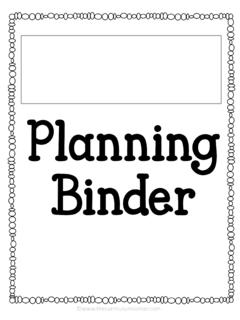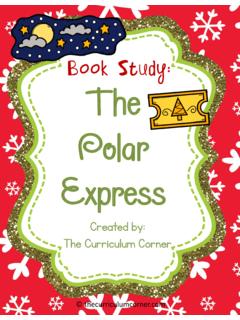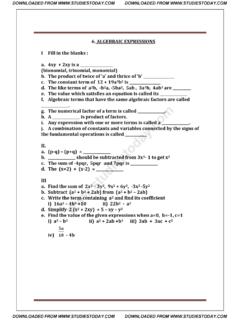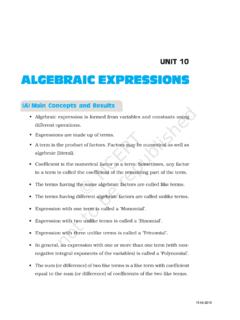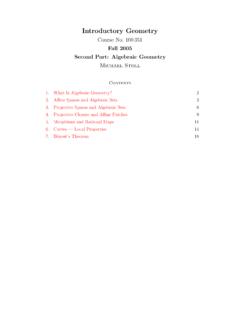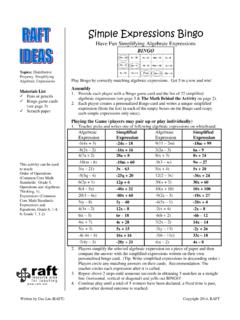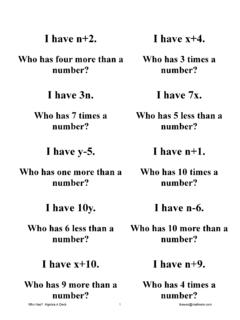Transcription of Operations & Algebraic Thinking - The Curriculum …
1 3rd Grade Math Operations & Algebraic Thinking CCSS I Can Statements I can understand multiplication by Thinking about groups of objects. I can understand division by Thinking about how one group can be divided into smaller groups. I can use what I know about multiplication and division to solve word problems. I can find the missing number in a multiplication or division equation. I can use the Commutative property of multiplication. (I know that if 6 x 4 = 24, then 4 x 6 = 24.) I can use the Associative property of multiplication. (To figure out 3 x 5 x 2, I can multiply 3 x 5 = 15, then 15 x 2 = 30 OR multiply 5 x 2 = 10, then 3 x 10 = 30.)
2 I can use the Distributive property of multiplication. (To figure out 8 x 7, I can think of 8 x (5 + 2) which means (8 x 5) + (8 x 2) = 40 + 16 = 56.) I can find the answer to a division problem by Thinking of the missing factor in a multiplication problem. (I can figure out 32 8 because I know that 8 x 4 = 32.) I can multiply and divide within 100 easily and quickly because I know how multiplication and division are related. I can solve two-step word problems that involve addition, subtraction, multiplication and division. I can solve two-step word problems by writing an equation with a letter in place of the number I don't know.
3 I can use mental math to figure out if the answers to two-step word problems are reasonable. I can find patterns in addition and multiplication tables and explain them using what I know about how numbers work. 3rd Grade Math Number & Operations In Base Ten CCSS I Can Statements I can use place value to help me round numbers to the nearest 10 or 100. I can quickly and easily add and subtract numbers within 1000. I can multiply any one digit whole number by a multiple of 10 (6 x 90, 4 x 30). 3rd Grade Math Number & Operations - Fractions CCSS I Can Statements I can show and understand that fractions represent equal parts of a whole, where the top number is the part and the bottom number is the total number of parts in the whole.
4 I can understand a fraction as a number on the number line by showing fractions on a number line diagram. I can label fractions on a number line because I know the space between any two numbers on the number line can be thought of as a whole. I can show a fraction on a number line by marking off equal parts between two whole numbers. I can understand how some different fractions can actually be equal. I can compare fractions by reasoning about their size. I can understand two fractions as equivalent (equal) if they are the same size or at the same point on a number line. I can recognize and write simple equivalent (equal) fractions and explain why they are equal using words or models.
5 I can show whole numbers as fractions. (3 = 3/1) I can recognize fractions that are equal to one whole. (1 = 4/4) I can compare two fractions with the same numerator (top number) or the same denominator (bottom number) by reasoning about their size. I can understand that comparing two fractions is only reasonable if they refer to the same whole. I can compare fractions with the symbols >, =, < and prove my comparison by using models. 3rd Grade Math Measurement & Data CCSS I Can Statements I can tell and write time to the nearest minute. I can measure time in minutes. I can solve telling time word problems by adding and subtracting minutes.
6 I can measure liquids and solids with grams (g), kilograms (kg) and liters (l). I can use addition, subtraction, multiplication and division to solve word problems about mass or volume. I can make a picture or bar graph to show data and solve problems using the information from the graphs. I can create a line plot from measurement data, where the measured objects have been measured to the nearest whole number, half or quarter. I can understand that one way to measure plane shapes is by the area they have. I can understand that a "unit square" is a square with side lengths of 1 unit and it is used to measure the area of plane shapes.
7 I can cover a plane shape with square units to measure its area. I can measure areas by counting unit squares (square cm, square m, square in, square ft). I can understand area by Thinking about multiplication and addition. I can find the area of a rectangle using square tiles and also by multiplying the two side lengths. I can solve real world problems about area using multiplication. I can use models to show that the area of a rectangle can be found by using the distributive property (side lengths a and b+c is the sum of a x b and a x c). I can find the area of a shape by breaking it down into smaller shapes and then adding those areas to find the total area.
8 I can solve real world math problems using what I know about how to find the perimeter of shapes. 3rd Grade Math Geometry CCSS I Can Statements I can place shapes into categories depending upon their attributes (parts). I can name a category of many shapes by looking at their attributes (parts). I can recognize and draw quadrilaterals (shapes with four sides) including rhombuses, rectangles and squares. I can divide shapes into parts with equal areas and show those areas as fractions.


